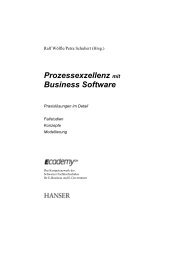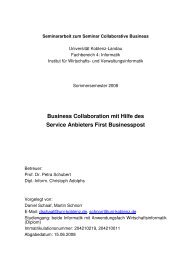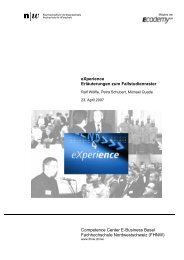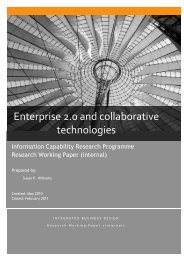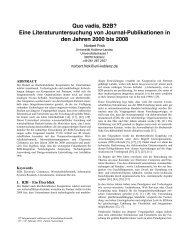HOW THE ORGANIZATIONS CHANGE IN ERP IMPLEMENTATION
HOW THE ORGANIZATIONS CHANGE IN ERP IMPLEMENTATION
HOW THE ORGANIZATIONS CHANGE IN ERP IMPLEMENTATION
Create successful ePaper yourself
Turn your PDF publications into a flip-book with our unique Google optimized e-Paper software.
YehHow the organizations change in <strong>ERP</strong> ImplementationMost project team members held doubts about projectcertainty.2. PoliticsShine needed to retain flexibility, including flexibility oforganization structure.The project ownership was unclear. Although of obviouslystrategic significance and operationally important, the projectwas originally generally seen as an MIS project.Dr. Fen lacked the authority to mandate action.The politics resulted in poor communication about almostevery aspect of the project when Dr. Fen was heading it. Therewas considerable dissatisfaction with Dr. Fen’s leadership.this project.The project module leaders and some project teammembers received the promotions and salary increasesafter the <strong>ERP</strong> system was regarded as successfullyimplemented.Shine didn’t announce any transition process plan for theproject team members post the implementation period. Asa result, staff seconded to the project felt insecure:In post implementation period, Shine still continuedprocesses improving and organization restructuring.DiscussionThe above case study analysis reveals the context of the <strong>ERP</strong> system implementation, the process over time of mutualinfluence between the system and its context. This section attempted to explore the organization changes combined with the<strong>ERP</strong> implementation.Culture Attitude and Value ChangeIndividual Attitude and Value ChangeBefore the implementation of the <strong>ERP</strong>, some users could work carelessly but had developed counteracting methods toovercome these errors. However, in the <strong>ERP</strong> system, all systems were integrated and such local compensations were notworkable on a system wide scale. Users needed to learn a new way of working. Change requires organizational members tounderstand a new way of performing processes, as well as how and why their processes have changed (Jamieson and Handzic,2003). This meant that people must change the way they think about their work and their organization, how they feel abouttheir enterprise and the type of relationships they develop within and across organizational boundaries (Lengnick-Hall et al.2004). The users need to learn the new ways of operating the system effectively and corporate in a network system. If <strong>ERP</strong>only changes tasks and the procedures people used to do their work, it is unlikely to provide long-term competitive benefits.To promote a sustained competitive advantage, organizations must be able to use <strong>ERP</strong> in distinctive ways. Unfortunately,user training in Shine was insufficient and ignored teaching users about the processes.10



